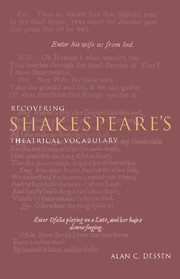Book contents
- Frontmatter
- Contents
- Preface
- Note on texts and old spelling
- 1 The problem, the evidence, and the language barrier
- 2 Lost in translation
- 3 Interpreting without a dictionary
- 4 Juxtapositions
- 5 Theatrical italics
- 6 Sick chairs and sick thrones
- 7 Much virtue in as
- 8 The vocabulary of “place”
- 9 “Romeo opens the tomb”
- 10 Vanish and vanishing
- Conclusion: So what?
- Notes
- Plays and editions cited
- Index
9 - “Romeo opens the tomb”
Published online by Cambridge University Press: 07 May 2010
- Frontmatter
- Contents
- Preface
- Note on texts and old spelling
- 1 The problem, the evidence, and the language barrier
- 2 Lost in translation
- 3 Interpreting without a dictionary
- 4 Juxtapositions
- 5 Theatrical italics
- 6 Sick chairs and sick thrones
- 7 Much virtue in as
- 8 The vocabulary of “place”
- 9 “Romeo opens the tomb”
- 10 Vanish and vanishing
- Conclusion: So what?
- Notes
- Plays and editions cited
- Index
Summary
“a Tomb, placed conveniently on the Stage”
James IVRegardless of the original staging or theatrical vocabulary, various “places” in Shakespeare's plays have captured the imaginations of generations of readers: the Forest of Arden; the castle at Elsinore; the Forum. Included in any such list, especially for those with a romantic bent, is the final sequence of Romeo and Juliet, for who knows not this scene of murder, suicide, and thwarted love – first in a graveyard, then in the Capulet tomb or monument? Here, moreover, the onstage configuration for the playgoer is (apparently) not in doubt, for the unusually explicit stage directions in the 1597 (“bad”) Quarto spell out what readers for centuries have taken for granted: “Paris strews the Tomb with flowers” (14V); “Romeo opens the tomb” (K1r).
My goal in this chapter, however, is to explore in detail these stage directions, the scene from which they come, and the larger category of tomb–monument scenes, for, unlike most readers today (including editors of Romeo), I find these and comparable signals highly problematic. Indeed, in the case of “Romeo opens the tomb,” I may understand Romeo, but, after much effort, I still have considerable difficulty with both opens and the tomb.
The reasons for those difficulties should by now be evident, for to tackle “Romeo opens the tomb” is to run head-on into the problem generated by Hosley's distinction between theatrical and fictional stage directions.
- Type
- Chapter
- Information
- Recovering Shakespeare's Theatrical Vocabulary , pp. 176 - 195Publisher: Cambridge University PressPrint publication year: 1995



